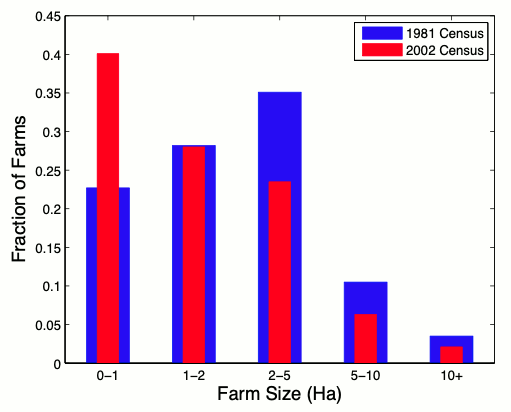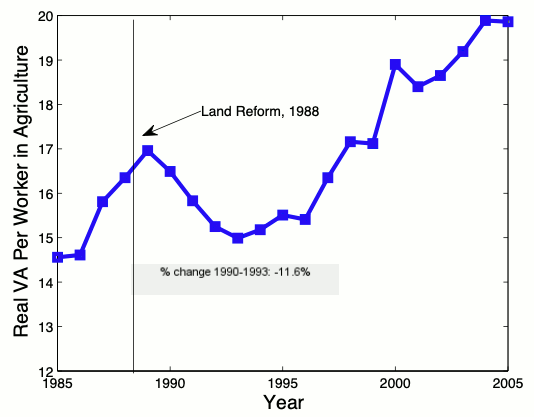
Land reforms, whilst well-intended, misallocate land and labour across farms, thereby reducing average farm size and agricultural productivity
Land reforms, the policies often associated with the redistribution of agricultural land from the land-rich to the land-poor or landless, have been one of the most active areas of agricultural policy initiatives in the developing world in the post-WWII period. Land reforms have also been a traditional theme in the development economics literature (De Janvry 1981, Binswanger-Mkhize et al. 2009).
Justification of land reforms
Land reforms are often justified on the basis of promoting equity, reducing poverty, securing the nutrition of land-poor households, correcting social injustices, and averting social unrest. In addition, there is a view in development economics arguing in favour of land-reform programmes also on efficiency grounds. This view is grounded in the long-standing empirical evidence documenting an inverse relationship between farm size and land productivity (Berry and Cline 1979, Carter 1984, Cornia 1985, Banerjee 1999). However, the empirical work studying the effects of land reforms on agricultural productivity or other key variables has been limited, and the existing evidence is mixed (Besley and Burgess 2000, Ghatak and Roy 2007, Banerjee et al. 2002, Bardhan and Mookherjee 2007).
In practice, many developing countries implemented land reforms by imposing a ceiling on the maximum amount of land that a farmer could hold: Bangladesh in 1984, Ethiopia in 1975, India in the early 1970s, Korea in 1950, Pakistan in 1972 and 1977, Sri Lanka in 1972, and Philippines in 1988. Importantly, the reforms were often accompanied by impediments to the functioning of the land market, such as severe restrictions on the selling and renting of the redistributed land.
While land reforms in the countries referenced above differed with respect to the imposed land ceiling, the pre-reform average farm size, as well as the degree of enforcement of the reform, in each of them there was a substantial decrease in average farm size a decade or two following the reform. This occurred despite the tendency for average farm size to increase over time as countries develop and go through the process of structural transformation by which people move out of agriculture.
In the context of our work linking farm size to agricultural productivity across countries (Adamopoulos and Restuccia 2014), a policy-induced drop in farm size is ground for concern from an efficiency standpoint. We studied a host of policies and institutions in developing countries that misallocate land and other productive resources across farmers, reducing farm size and agricultural productivity. Land reforms, imposing a ceiling on land holdings, and ‘shutting down’ the land market, reduce farm size and fall directly under the purview of policies misallocating land in agriculture.
The Philippine land reform
Given the historical incidence of land reforms and their importance on the policy and research agendas, in a recent paper (Adamopoulos and Restuccia 2019), we study the allocative efficiency implications of land reforms. We quantify the effects on farm size and agricultural productivity of a specific land reform episode, the 1988 Comprehensive Agrarian Reform Programme (CARP) in the Philippines, which: (i) was an extensive land redistribution programme, targeting 80% of the country’s farmland; (ii) imposed a restrictive ceiling of five hectares on existing land holdings; (iii) administratively reallocated the above-ceiling land to landless and smallholders; and (iv) severely restricted the transferability of the redistributed farm lands, with explicit prohibition of sale, lease, transfer, or donation for the first ten years.
Based on agricultural census data, the period after the reform shows a substantial reallocation of farms and land to smaller farm sizes, with average farm size dropping by about 30%. Figure 1 shows that the share of farms operating below one hectare of land increased from 23% in the 1981 census (prior to the reform) to 40% in the 2002 census (after the reform).
Figure 1 Changes in the farm-size distribution in the Philippines

Using data on agricultural value added per worker for the Philippines, Figure 2 indicates a substantial drop of about 12% in agricultural productivity between 1989 and 1993, a period shortly after the reform.
Figure 2 Agricultural labour productivity in the Philippines

Because the implementation of land reforms involve a substantial amount of time, a decade or more, it is important to separate from the time series data the effects of the reform from other changes occurring alongside the reform. For this reason, we quantify the effects of the reform by building a model of farm size in agriculture, which we combine with farm-level survey data from the Philippines. In the model farmers differ with respect to their productivity and the idiosyncratic distortions they may be facing in farming. These affect whether they want to be farm operators or farm workers, the size of the farm they choose to operate if they become operators, how many workers they hire, and what type of crop they wish to farm.
We implement the land reform in the model to replicate CARP: impose a ceiling of five hectares, reallocate the land to landless and smallholders, and shut down the land market. This reform affects farmer choices through all the above channels. Importantly, the survey data allow us to construct a panel that tracks the same set of farmers before and after the reform. The detailed data allow measuring agricultural inputs and outputs of different crops at the farm-level.
The effects of the reform
The model, calibrated to pre-reform farm data from the Philippines, implies that on impact the land reform reduces average farm size by 34% and agricultural productivity by 17%. The government intervention in the redistribution of land and ban on subsequent transfer are key for the magnitude of the results since a market allocation of the above-ceiling land produces only about one third of the size and productivity effects. The above effects may not be visible in the data over a longer horizon if there are other changes occurring in the economy alongside the land reform. These could include general growth in the economy or agriculture-specific growth enhancing changes such as the adoption of high yield variety seeds, which may mask the negative productivity effects of the land reform. Our model allows us to disentangle the productivity effects of the reform from other changes.
The model and data also allow us to assess the impact of the reform on operational farm size as opposed to owned land holdings. In practice, farmers could abide by the reform by redistributing land ownership among several family members or could face lax enforcement. Our results indicate that a full enforcement of the reform – whereby no farm operates above the five-hectare ceiling – would produce much larger negative impacts on average farm size (a decline of 41% versus 34% in the actual reform) and especially on agricultural productivity (a decline of 27% versus 17% in the actual reform).
Finally, we note that land reforms that constrain the size of farms may also induce effects on farm investment or other choices that impact farm-level productivity. We use our data on the panel of Philippines farms, and a difference-in-differences approach, which isolates the effect of the reform on the productivity growth of the affected farms. We find that the land reform had a significant negative productivity effect on the farms that were subjected to the reform.
Policy implications
While our analysis focuses on the institutional detail of the Philippine land reform, we think our conclusions have implications for other countries in the developing world that feature similar restrictive land-market institutions. Our analysis also sheds light on the components of the reform that are more costly in terms of productivity, which could provide guidance for policymakers.
Specifically, we conclude that policies and institutions that impede the operation of the land market could prove particularly detrimental when accompanying land reforms. A well-functioning rental market for land can substantially mitigate the negative effects of imposing a more egalitarian distribution of land holdings, as these markets would tend to disassociate operated land from land rights. Delinking land use from land rights can also have substantial effects on migration and occupation decisions further contributing to increases in farm size and productivity in agriculture (de Janvry et al. 2015, Adamopoulos et al. 2017). Even if land reforms could potentially generate a productivity gain by channelling land to constrained but productive farmers, the way the reforms are implemented in practice, by administratively reallocating land on the basis of size rather than productivity, critically miss out on this potential gain.
Our analysis focuses on the productivity effects of land reforms, abstracting from other considerations that usually motivate the implementation of reforms. Assessing the different economic and political costs and benefits, and weighing their importance against the potential productivity losses, remains a fruitful area for future research.
References
Adamopoulos, T, L Brandt, J Leight and D Restuccia (2017), Misallocation, selection and productivity: A quantitative analysis with panel data from China, NBER Technical Report.
Adamopoulos, T and D Restuccia (2019), “Land reform and productivity: A quantitative analysis with micro data”, NBER working paper 25780.
Adamopoulos, T and D Restuccia (2014), “The size distribution of farms and international productivity differences”, American Economic Review 104(6): 1667–97.
Banerjee, A (1999), “Land reforms: Prospects and strategies”, In Pleskovic, B and J Stiglitz (eds), Annual World Bank Conference on Development Economics, World Bank Report 21837: 99– 24.
Banerjee, A, P Gertler and M Ghatak (2002), “Empowerment and efficiency: Tenancy reform in West Bengal", Journal of Political Economy 110(2): 239–280.
Bardhan, P and D Mookherjee (2007), “Land reform and farm productivity in West Bengal”, Unpublished manuscript, Boston University.
Berry, R and W Cline (1979), Agrarian structure and productivity in developing countries: A study prepared for the International Labour Office within the framework of the World Employment Programme, Johns Hopkins University Press.
Besley, T and R Burgess (2000), “Land reform, poverty reduction, and growth: Evidence from India”, Quarterly Journal of Economics 115(2): 389–430.
Binswanger-Mkhize, H, C Bourguignon and R van den Brink (2009), Agricultural land redistribution: Toward greater consensus, World Bank Publications.
Carter, M (1984), “Identification of the inverse relationship between farm size and productivity: An empirical analysis of peasant agricultural production”, Oxford Economic Papers 36: 131–145.
Cornia, G (1985), “Farm size, land yields and the agricultural production function: An analysis for fifteen developing countries”, World Development 13(4): 513–534.
De Janvry, A (1981), “The role of land reform in economic development: Policies and politics”, American Journal of Agricultural Economics 63(2): 384-392.
De Janvry, A, K Emerick, M Gonzalez-Navarro, and E Sadoulet (2015), “Delinking land rights from land use: Certification and migration in Mexico”, American Economic Review 105(10): 3125-49.
Ghatak, M and S Roy (2007), “Land reform and agricultural productivity in India: A review of the evidence”, Oxford Review of Economic Policy 23(2): 251–269.


